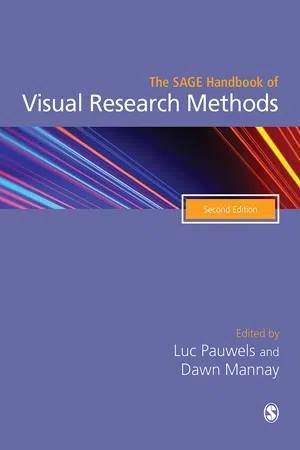
The SAGE Handbook of Visual Research Methods
- 776 pages
- English
- ePUB (mobile friendly)
- Available on iOS & Android
The SAGE Handbook of Visual Research Methods
About this book
The second, thoroughly revised and expanded, edition of The SAGE Handbook of Visual Research Methods presents a wide-ranging exploration and overview of the field today. As in its first edition, the Handbook does not aim to present a consistent view or voice, but rather to exemplify diversity and contradictions in perspectives and techniques.
The selection of chapters from the first edition have been fully updated to reflect current developments. New chapters to the second edition cover key topics including picture-sorting techniques, creative methods using artefacts, visual framing analysis, therapeutic uses of images, and various emerging digital technologies and online practices. At the core of all contributions are theoretical and methodological debates about the meanings and study of the visual, presented in vibrant accounts of research design, analytical techniques, fieldwork encounters and data presentation.
This handbook presents a unique survey of the discipline that will be essential reading for scholars and students across the social and behavioural sciences, arts and humanities, and far beyond these disciplinary boundaries.
The Handbook is organized into seven main sections:
PART 1: FRAMING THE FIELD OF VISUAL RESEARCH
PART 2: VISUAL AND SPATIAL DATA PRODUCTION METHODS AND TECHNOLOGIES
PART 3: PARTICIPATORY AND SUBJECT-CENTERED APPROACHES
PART 4: ANALYTICAL FRAMEWORKS AND PERSPECTIVES
PART 5: MULTIMODAL AND MULTISENSORIAL RESEARCH
PART 6: RESEARCHING ONLINE PRACTICES
PART 7: COMMUNICATING THE VISUAL: FORMATS AND CONCERNS
Frequently asked questions
- Essential is ideal for learners and professionals who enjoy exploring a wide range of subjects. Access the Essential Library with 800,000+ trusted titles and best-sellers across business, personal growth, and the humanities. Includes unlimited reading time and Standard Read Aloud voice.
- Complete: Perfect for advanced learners and researchers needing full, unrestricted access. Unlock 1.4M+ books across hundreds of subjects, including academic and specialized titles. The Complete Plan also includes advanced features like Premium Read Aloud and Research Assistant.
Please note we cannot support devices running on iOS 13 and Android 7 or earlier. Learn more about using the app.
Information
1 Visual Dialogues Across Different Schools of Thought
Visual Research in a Visual Culture
- – researching the Production Context (the who, what, where, when, how and why; for example, through ethnographic research, interviews and surveys);
- – researching the Visual Artefact or Phenomenon (through content-related and formal analysis, focusing on, among other things, technology, characteristics of the medium, genre and style);
- – researching the Utilization Context (for example, through audience analysis, and with a focus on disclosing situational factors, subcultural connotations and political implications).
Renewing the Visual Dialogue
Table of contents
- Cover
- Half Title
- Title Page
- Copyright Page
- Contents
- List of Figures
- List of Tables
- Notes on the Editors and Contributors
- Acknowledgements
- 1 Visual Dialogues Across Different Schools of Thought
- Part I Framing the Field of Visual Research
- 2 An Integrated Conceptual and Methodological Framework for the Visual Study of Culture and Society
- 3 Looking Two Ways: Mapping the Social Scientific Study of Visual Culture
- 4 Visual Studies and Empirical Social Inquiry
- 5 Seeing Things: Visual Research and Material Culture
- Part II Visual and Spatial Data Production Methods and Technologies
- 6 Rephotography for Documenting Social Change1
- 7 Rephotography in Landscape Research
- 8 Videography: An Interpretative Approach to Video-Recorded Micro-Social Interaction
- 9 Eye-Tracking as a Method of Visual Research
- 10 Expanding Cartographic Practices in the Social Sciences
- 11 Participatory Geographic Information Systems in Visual Research
- 12 Visualization in Social Analysis1
- 13 Visual Research Methods in the Design Process
- Part III Participatory and Subject-Centered Approaches
- 14 Methodological Variation in Participant Visual Media Production
- 15 Community-Based Participatory Video and Social Action
- 16 Digital Storytelling as a Research Method
- 17 Photovoice: A Critical Introduction
- 18 Using Drawing in Visual Research: Materializing the Invisible
- 19 Picture-Sorting Techniques: Card-Sorting and Q-Sort as Alternative and Complementary Approaches in Visual Social Research
- 20 Artefacts, Third Objects, Sandboxing and Figurines in the Doll's House
- 21 The Therapeutic Use of Photography: Phototherapy and Therapeutic Photography1
- Part IV Analytical Frameworks and Perspectives
- 22 Quantitative Content Analysis of the Visual
- 23 Visual Semiotics: Key Concepts and New Directions
- 24 Advances in Visual Rhetorical Analysis
- 25 Iconology and Documentary Method in the Interpretation of Divergent Types of Visual Materials
- 26 Ethnomethodology and the Visual Practices of Looking, Visualization, and Embodied Action
- 27 Methodological Approaches to Disclosing Historic Photographs
- 28 Researching Film and History: Sources, Methods, Approaches
- Part V Multimodal and Multisensorial Research
- 29 Multimodality and Multimodal Research
- 30 Visual and Multimodal Framing Analysis
- 31 Multimodal Critical Discourse Analysis: How to Reveal Discourses of Health and Ethics in Food Packaging
- 32 How to ‘Read’ Images with Texts: The Graphic Novel Case
- 33 A Multisensory Approach to Visual Methods
- 34 Rapid Prototyping for Social Science Research
- Part VI Researching Online Practices
- 35 A Multimodal Model for Exploring the Material Culture of Digital Networked Platforms and their Practices
- 36 Contemporary Landscapes of Visual and Digital Communication: The Interplay of Social, Semiotic, and Technological Change
- 37 Understanding Online Images: Content, Context and Circulation as Analytic Foci
- 38 Visual and Affective Analysis of Social Media
- Part VII Communicating the Visual: Formats and Concerns
- 39 Creating Visual Essays: Narrative and Thematic Approaches
- 40 Anthropological Filmmaking: An Empirical Art
- 41 Visual Ethnography and Emerging Digital Technologies
- 42 Revisualizing Data: Engagement, Impact and Multimodal Dissemination
- 43 Making Arguments with Images: Visual Scholarship and Academic Publishing
- 44 Visual Ethics Beyond the Crossroads1
- 45 Legal Issues of Using Images in Research
- Index